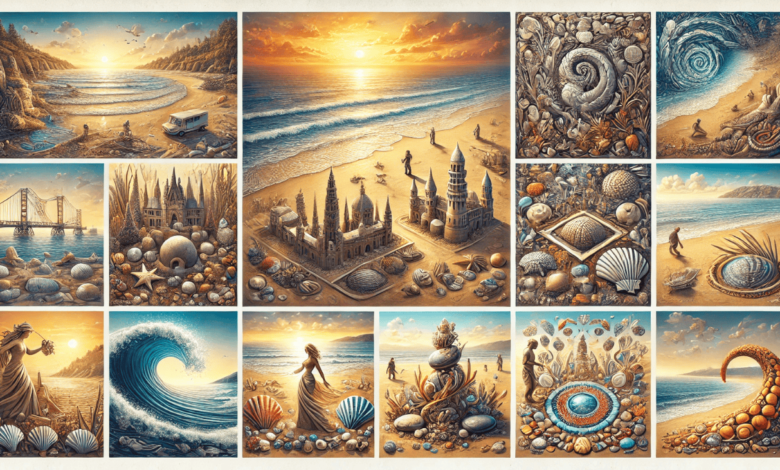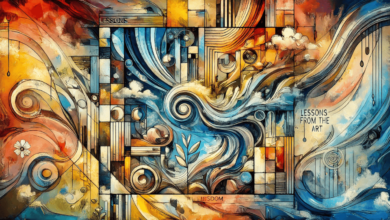The Ultimate Guide to Beach Art: Creativity Inspired by the Sea

What is Beach Art?
The beach is more than just a place for relaxation; it is also a stunning natural canvas for creativity. Beach art is an expansive term that covers various artistic expressions created by or inspired by the seaside. From delicate sand sculptures and intricate rock balancing to stunning paintings and environmental artwork, beach art brings together nature and human imagination in unique and mesmerizing ways.
In this guide, we will explore the many forms of beach art, its cultural and emotional significance, how you can create your own, and why it continues to captivate artists and nature lovers worldwide.
The Many Forms of Beach Art
Sand Art – A Fleeting Masterpiece
One of the most captivating forms of beach art is sand art. Artists create breathtaking designs using nothing but sand and water. Sand sculptures can range from small, intricate figures to life-sized castles and even complex landscapes. Some of the most famous sand artists, such as Jim Dene van and Andres Amador, have transformed beaches into temporary art galleries, showcasing grand geometric designs and awe-inspiring sculptures.
The beauty of sand art lies in its impermanence; the tide eventually washes it away, making each piece a fleeting masterpiece.
Driftwood and Seashell Sculptures
For a more lasting form of beach art, driftwood and seashell sculptures provide endless possibilities. Collected from the shoreline, these natural materials are shaped into striking artworks that often depict marine life, abstract forms, or even functional items like furniture. Driftwood sculptures are commonly found in coastal towns, and many artists create magnificent installations from these sun-bleached remnants.
Seashell mosaics are another enchanting form of beach art. By arranging shells of different colors and sizes, artists craft intricate patterns that celebrate the natural beauty of the ocean.
Beach Rock Arrangements – Balance and Beauty
Rock stacking is a form of beach art that combines balance, patience, and creativity. Artists carefully place stones atop one another, creating breathtaking sculptures that seem to defy gravity. Some rock arrangements include messages or symbols that hold spiritual significance. This form of art encourages mindfulness and connection with nature, making it a therapeutic activity for many.
Coastal Murals and Paintings
Not all beach art is made on the shore. Many artists take inspiration from the ocean and translate it into breathtaking paintings and murals. Coastal towns around the world feature murals that depict marine life, crashing waves, and seafaring culture. These murals often serve as powerful reminders of our deep connection with the sea.
Environmental Beach Art – Raising Awareness Through Creativity
A growing trend in beach art involves creating sculptures and installations from beach debris, particularly plastic waste. This artistic approach transforms discarded materials into striking artworks that highlight the urgent issue of ocean pollution. Artists like Alejandro Duran use washed-up plastic to create colorful landscapes, turning environmental concerns into visually impactful statements.
The Emotional and Cultural Impact of Beach Art
The Therapeutic Nature of Beach Art
Creating beach art can be a deeply meditative experience. The rhythmic sound of waves, the feel of the sand, and the openness of the shore all contribute to a stress-free environment that fosters creativity. Many people find that making art at the beach promotes relaxation, mindfulness, and mental clarity.
Cultural and Historical Significance
Throughout history, coastal communities have incorporated beach art into their traditions. Indigenous groups have long used beach materials for artistic and spiritual expressions, from Polynesian wood carvings to Celtic stone arrangements along the shore. Today, modern festivals celebrate beach art, attracting visitors who appreciate the intersection of nature and creativity.
How to Create Your Own Beach Art
Anyone can engage in beach art, whether you’re a professional artist or just looking for a fun beach activity. Here are some simple ways to get started:
- Sand Drawings – Use a stick or rake to create temporary designs in the sand.
- Shell Mosaics – Collect colorful seashells and arrange them into patterns or pictures.
- Driftwood Sculptures – Assemble driftwood pieces into creative shapes.
- Rock Balancing – Challenge yourself to balance stones in unique formations.
- Beach Photography – Capture the beauty of the ocean, sunset, and artistic elements of the beach.
FAQs About Beach Art
What is the most popular form of beach art?
Sand sculptures are one of the most popular forms of beach art, attracting artists and spectators worldwide. Festivals dedicated to sand art, such as the World Championship of Sand Sculpting, showcase some of the most incredible creations.
Can beach art be permanent?
Most beach art is temporary, especially sand art and rock arrangements. However, sculptures made from driftwood, seashells, or beach debris can be preserved and displayed for years.
What materials are used in beach art?
Common materials used in beach art include sand, driftwood, seashells, beach rocks, and even recycled ocean debris. Many artists also use paints and dyes to enhance their creations.
How can beach art help the environment?
Environmental beach art raises awareness about pollution and marine conservation. By transforming beach waste into meaningful artworks, artists highlight the impact of human activity on the ocean and inspire action towards sustainability.
Conclusion
Beach art is a remarkable blend of creativity and nature, offering endless opportunities for artistic expression. Whether you admire intricate sand sculptures, collect driftwood for sculptures, or capture stunning coastal scenes in a painting, the beach provides a perfect backdrop for artistic inspiration. Next time you visit the shore, take a moment to appreciate the natural beauty around you—or better yet, create some beach art of your own!



